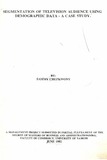| dc.contributor.author | Chepkwony, Sammy | |
| dc.date.accessioned | 2013-06-24T13:47:58Z | |
| dc.date.available | 2013-06-24T13:47:58Z | |
| dc.date.issued | 1992-06 | |
| dc.identifier.citation | Degree Of Master of Business and Administration | en |
| dc.identifier.uri | http://erepository.uonbi.ac.ke:8080/xmlui/handle/123456789/39105 | |
| dc.description | A management research project submitted in partial fulfillment
of the requirements for the Degree Of Master of Business and
Administration (MBA), Faculty of Commerce, University Of
Nairobi. | en |
| dc.description.abstract | This case study is concerned with segmenting a restricted TV audience in Kenya using
demographic characteristics of the audience. The restricted audience chosen was the staff of the
University of Nairobi.
A sample of this audience was asked to indicate their television viewing patterns and
preferences. The data collected was analysed using the statgraphics computer package.
Proportions were computed and presented by way of tables and discussions to reveal various
features of television viewership. Data was also presented by way of mean scores.
Cross tabulation and Chi-square analysis was done to uncover any significant associations
between demographic characteristics of the viewers and their viewing preferences. This showed
that age, sex and marital status were viable characteristics for segmenting television audience
in the population studied.
Three segments were identified based on age, sex and marital status and their TV viewing
characteristics described. Segmentation using these demographic variables can become a useful
way of identifying target markets within the restricted population. Segments include people who
have similar viewing preferences and/or can regularly view TV at specified times of the day.
The findings resulted in the following conclusions:
(1) That the restricted TV audience can be segmented using some of the demographic
characteristics of the audience.
(2) Segmentation using some demographic characteristics has proved useful in identifying target
markets within the restricted population. The target markets identified included people who
have similar viewing preferences and/or can regularly view TV at specified times of the day.
(3) That age, sex, and marital status may be significant variables in identifying market segments
in similar TV audiences.
The findings are recommended for use in initiating further research into TV audiences in
Kenya and elsewhere. The results of such a study can be of benefit to advertisers using TV, and
the managers and editors of each network and also researchers.
The research results may only be applied after careful consideration of the limitations of
this study which include the restricted nature of the population studied.
It should be noted that the present study can act as a basis for further research. Suggestions
for further investigations are therefore made. | en |
| dc.language.iso | en | en |
| dc.publisher | University of Nairobi | en |
| dc.title | Segmentation of television audience using demographic data - a case study | en |
| dc.type | Thesis | en |
| local.publisher | Faculty of Commerce | en |

